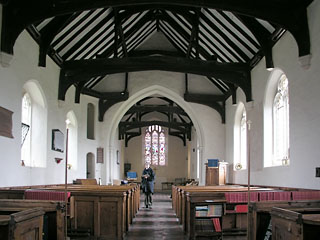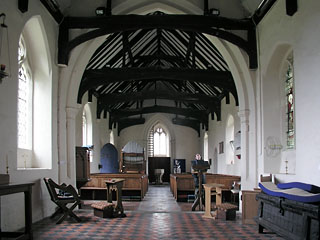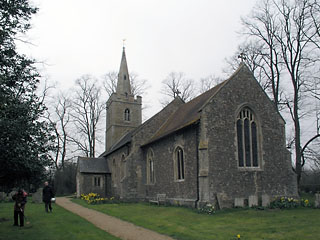St Mary is a little church, and (aside from a slightly older tower and some reused stonework in the chancel) dates almost entirely from the late 14th and early 15th centuries. I’ve commented elsewhere that it’s nice to be reminded that the Perpendicular style doesn’t just apply to grand buildings like King’s College Chapel or the church at Burwell: it can work equally well on a small scale.
St Mary has no aisles, and the tower is short and unbuttressed, but it sits like an intricate jewellery box in its verdant churchyard. When we visited it was attended by choirs of daffodils, brilliant yellow in the grey morning light.
Inside, I was struck by the nave roof. It is a 15th century structure, with octagonal queenposts rising from very solid tie-beams. Against each end of the nave, the central parts of the tie-beams have been cut away to accommodate the chancel and tower arches, which is unusual (but then, this is a very low roof, comparatively speaking).
The roof in the chancel appears to be of a similar design and date but plastered boards keep most of its struts and supports hidden.
There are several interesting pieces of ancient graffiti dotted around. Underneath the chancel arch (which is very broad and low) on the north jamb is scrawled marmaduke messynden off helynge yn the conty off lyncolne. Marmaduke Messynden was a 16th century stonemason, and ‘Helynge’ is believed to be Helmsby.
Back in the nave, there is a carving of a windmill by the south door. It partially obscures an earlier Latin inscription includes the words ‘absubita peste’ and ‘die dicto’ – the first bit meaning something like ‘after the plague’, I think. All three are fascinating glimpses of the parts of history that otherwise disappear, having no purchase on the smooth stone of high art and architecture.
I like quite a lot of graffiti in general for that reason: is there really much difference between these illicit scribblings and the spray-painted tags on the railway bridges of South London? Both are the voices of the voiceless.
Hardwick is most famous for artwork that lies somewhere between high and low. On the south wall, we can see a small part of one of Cambridgeshire’s most famous medieval wall-paintings. I say ‘a small part’ because (after a brief spell when the 16th century whitewash was removed during a general restoration) it was painted over in 1856 by the vicar, worried that the parish had no money to conserve them and aware that they were disintegrating fast. The part that has been uncovered is tantalising, though.
A king, with a big crown and a sword, rides on a large lion with a human face. Above him are two smaller figures. On the left is a man with red-gold hair, dressed in a white robe with gold tassels. He faces a woman who carries a pot and wears a wimple. It is generally believed that this is part of a depiction of the Seven Deadly Sins, painted between 1460 and 1480.
The sins (Pride, Envy, Wrath, Avarice, Gluttony, Lust and Sloth) appear in order of ascending seriousness from the west to the east. The lion and king represent Pride, and are the easternmost (and therefore most deadly) of the groups.
The parish of Hardwick have an excellent website with lots of information about the murals, and I strongly recommend visiting it. Amongst other things, there is detailed information about the iconography, and a drawing that was made in 1858 of the whole wall. I hope that at some point there is enough money to uncover the whole lot and restore it properly: it looks glorious.
St Mary was locked when we visited, but there are keyholders listed





